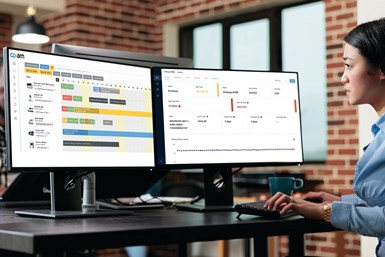EOS Adopts Materialise CO-AM Software Platform to Improve Internal Additive Manufacturing Efficiency
The CO-AM platform is designed to enhance traceability and connectivity in the company’s internal additive manufacturing processes.
EOS has adopted the CO-AM software platform from Materialise to manage its additive manufacturing (AM) processes for application engineering and internal sinter production. CO-AM integrates with EOS’ existing infrastructure and will be used to improve the efficiency of AM production across global facilities.
EOS maintains production sites across Germany, the U.S. and various locations in the Asia-Pacific region. The globally distributed AM capacities serve internal demands and support EOS’ application engineering services. EOS has adopted CO-AM to manage these AM processes and enhance traceability and efficiency. The Materialise CO-AM Software Platform provides access to a full range of software tools to plan, manage and optimize every step of the 3D printing process.
EOS integrated CO-AM into its existing infrastructure, such as data and customer relationship management software, and connected it to its fleet of equipment. CO-AM will support the EOS internal AM workflow from order management through production scheduling, build monitoring and postprocessing.
“It is critical that tools such as CO-AM are able to provide improvements in the efficiency of AM production that outweigh the cost of using the tool,” says Trevor Kirsten, EOS head of digital manufacture. “With enhanced connectivity and traceability in CO-AM, we aim to improve efficiency in our production process by reducing powder consumption and the number of machines required for our operations.”
The CO-AM Scheduler shows both planned and actual printer activities to support utilization rate improvements. Within the platform, Materialise’s AMWatch software enables operators and engineers to monitor build status and process sensor data to decrease scrap rates and improve quality control. EOS team members will also have access to data in the CO-AM platform gathered through a shop-floor iOS application. This digital feedback from the factory floor will help them to monitor unpacking, depowdering and postprocessing activities in real time.
“One of the primary benefits of the CO-AM platform is the open and flexible architecture that allows companies to integrate the software with their existing manufacturing technology and adapt it to their needs,” says Jim Carlson, Materialise head of global customer success. “EOS and Materialise share a long partnership and we are looking forward to collaborating with them to create a more efficient and connected additive workflow.”
- Lean how Materialise continues to expand its CO-AM Platform with additional technology partners and Magics integration. With the new partners, Materialise says it delivers on the promise to connect and automate all steps of the AM process, including automating design, labeling, machine monitoring and postprocessing.
- Read how Materialise’s CO-AM Software for serial additive manufacturing production gives manufacturers cloud-based access to a full range of software tools that enable them to plan, manage and optimize every stage of their additive manufacturing operations.
Related Content
-
Hybrid Additive Manufacturing Improves Debarking Knife Tip Strength and Production Efficiency
Nicholson Manufacturing chose the Mastercam APlus specialized add-on to unlock hybrid manufacturing for making its debarker knife tips, enabling it to add durable layers to the wear surfaces of the tips to make them more resilient while also making the production process more efficient.
-
Implicit Modeling for Additive Manufacturing
Some software tools now use this modeling strategy as opposed to explicit methods of representing geometry. Here’s how it works, and why it matters for additive manufacturing.
-
Decentralized Manufacturing Network Aims to Make 3D Printers a Shared Global Resource
The 3DOS additive manufacturing network will let OEMs and creators take advantage of open 3D printer capacity anywhere in the world.















